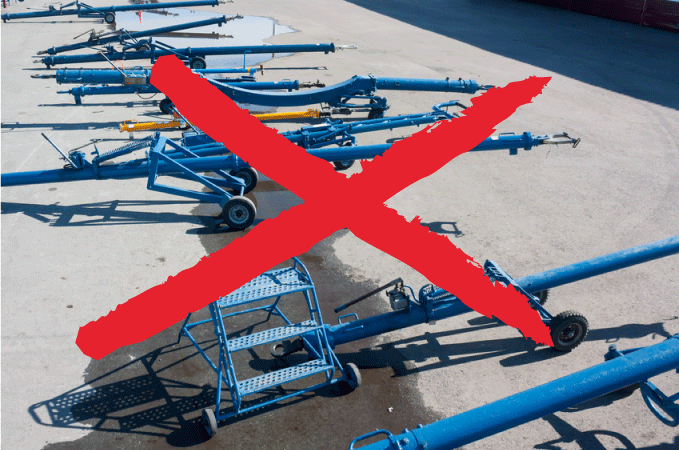Towbars are still your weapon of choice when it comes to pushback and other ground operations? Then you are currently missing out on huge business and ground handling opportunities to save time, money, and nerves. Here’s why.
Wherever you go: If there is an airplane there is quite likely a towbar nearby. Towbar tugs are the most conventional way of transporting a plane on the ground and a piece of aviation history – we’ll give them that. But like with every historical tool, one day, technology moves on, and everyone who doesn’t move along draws the short straw. So – for the love of your business – stop using towbars for these 9 reasons.
#1: Special training is leading to additional costs
Operating a towbar is not an easy thing to do. Not only do you need an excellent spatial perception. This job also requires plenty of special licenses and qualifications and the training costs quite some money and time. Thus, finding a good towbar tug driver is tough and his employment will be an expensive endeavor.
Read more about how you can save money on training here in our blog.
#2: Aircraft towbars take long to be installed
When you are installing a towbar you have to do most of it on your own. Unless you are The Flash, this procedure can take a lot of time – and manpower, too. Watch for example these eight (!) men attach a towbar to an Antonov 124 for six minutes:
Painful to watch, isn’t it? Imagine if every pushback would imply six minutes for the attachment of a towbar alone (not to mention the detachment). At an airport, there can easily be 700 launches and landings a day. This would mean, that overall this procedure eats up over 58 hours, every day! Multiply this by the number of people involved in every operation and their wages and you’ll get a figure that you just don’t want to be paying if you know you could avoid it.
#3: Towbars are expensive
Not only is the staff a cost factor, the towbars themselves aren’t cheap either. One single towbar can cost a five-figure amount – excluding the tug or any other accessories. This might seem acceptable as a one-time investment, but hold up. This still wasn’t it.
#4: Every aircraft model needs its own towbar
And this is one of the reasons why this previous point is so dramatic. Imagine you are an FBO where dozens of pilots a day want to store their airplanes – and everyone of them has another model. If you don’t want to send your customers home you need to be prepared and therefore you need to buy a bunch of different towbars in advance. “Well, that’s quite an investment”, you think? Damn right. Oh, and have you already thought about where to store all these towbars?
#5: Barely any safety measures
A towbar has barely any safety measures. It works mechanically and has, therefore, no sensors that can measure overload or oversteering. Most towbars work with parts that are supposed to break off in case this happens. These parts need to be bought again and replaced afterward. This isn’t just old-school – it’s plainly outdated.
#6: Towbars cause dangerous and expensive accidents
An airplane getting its nose gear ripped off is quite interesting to watch, really. These kinds of accidents do happen! You can look at one in the 6th video of this article in our blog. Luckily nobody got hurt, but do you want something like this to happen at your airport? Even if a towbar isn’t damaging any airplanes right now, it’s quite good at breaking itself. Especially towbars with supporting wheels in the middle are likely to bend if they are driven over a bump.
#7: Aircraft tugs with a towbar need to be extra heavy
If a tug wants to get an aircraft moving with the help of a towbar it needs to be heavy, like really heavy. About 15 % of the aircraft’s weight to be precise. These heavy tugs use a huge amount of fuel and wear their parts out quicker. An economical and ecological disaster.
#8: Limited speed
As we have already observed, towbars aren’t the safest. Therefore, towing an aircraft at 30 km/h (18.6 mph/16.2 kn) is risky if you aren’t using a towbarless tug (TBL). In the production line or when it comes to maintenance, airplanes sometimes have to be moved over longer distances. A tug that can move at higher speeds can save you a lot of valuable time.
#9: Your rivals never rest
The tow bar is a relic of bygone times and your competitors know that. It is uneconomic, inefficient and sometimes even dangerous. That’s why most FBOs, MROs, hangars, airlines and airports are upgrading to towbarless tugs right now or already did. And they are already saving money on it and profiting from it big-time. Everyone who doesn’t keep up with technology in this business gets left behind.
Conclusion to towbars
Towbars are an entrepreneurial nightmare. Their overall costs are incredibly high and they have a serious lack of security. Everyone who wants to see his revenues rise should quit investing in towbars and start investing in a technology that actually provides an ROI.
If you want to find out how you can increase profitability and outperform your competitors, we are glad to help you find the best solution for your business. Get in touch!


Comments